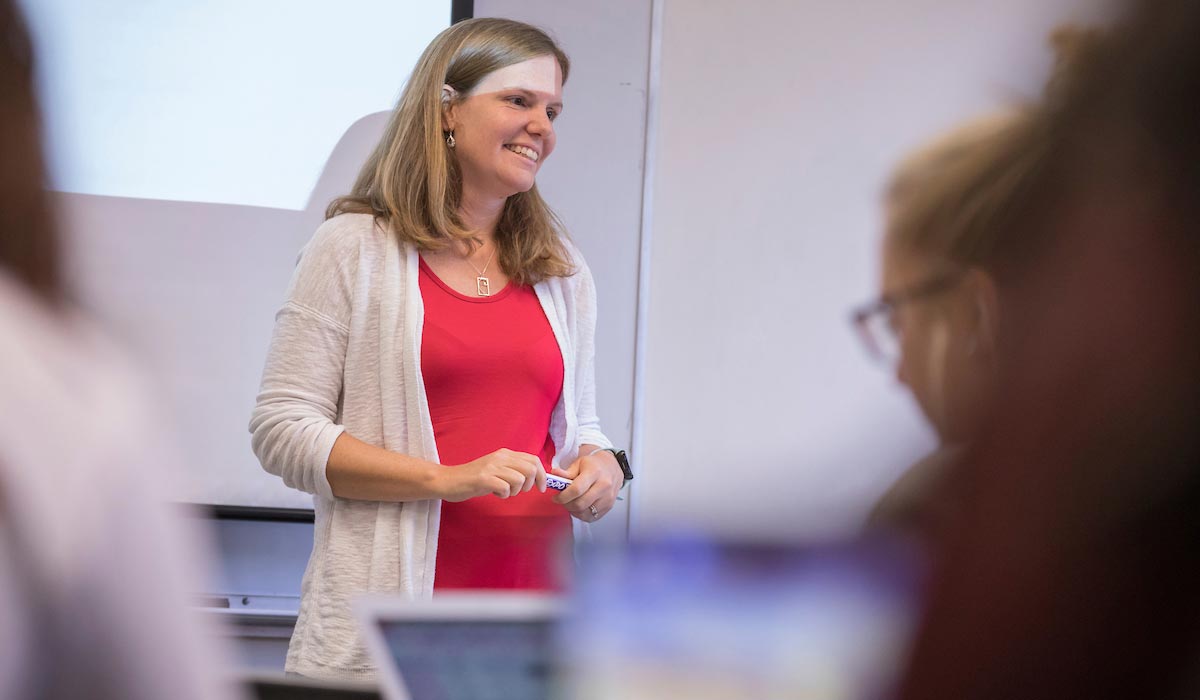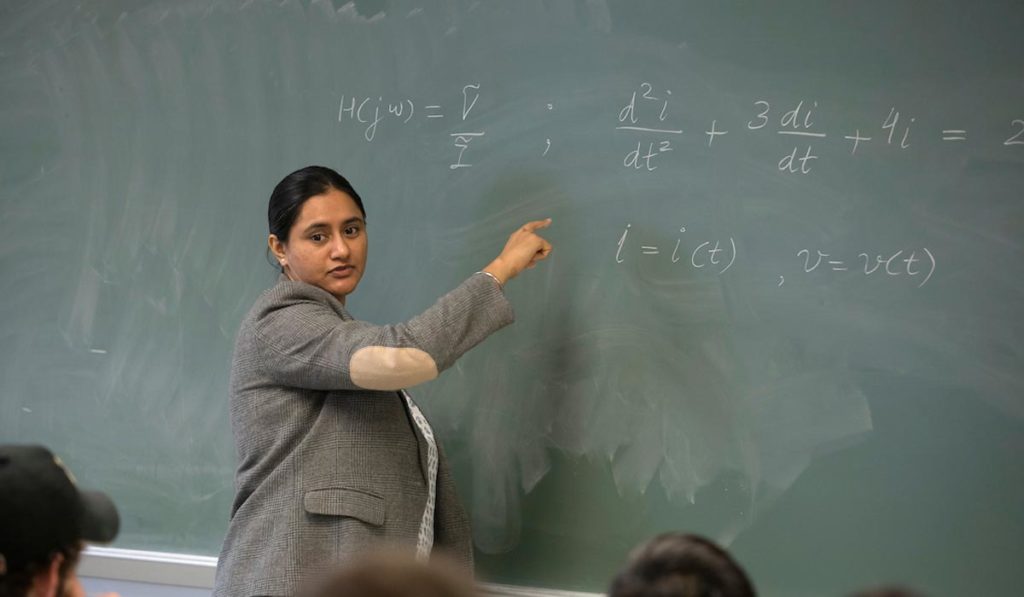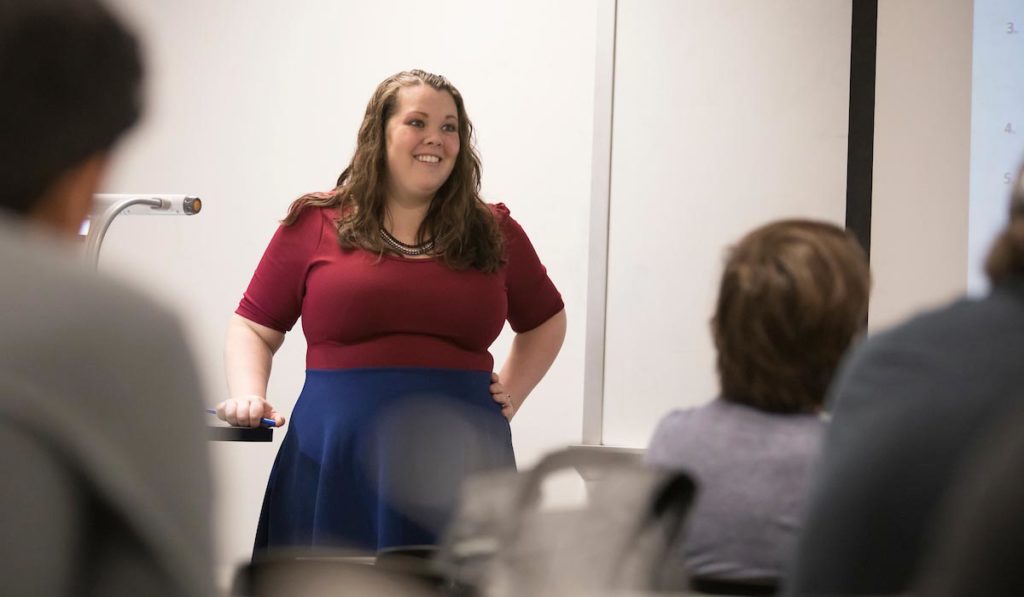Teaching students is priority No. 1
Posted by Lindsay Stanford

Michelle Schwartze teaches S&T’s future teachers. She says that building a relationship with her students leads to success in the classroom. She believes S&T faculty do a great job of keeping up with the latest educational trends.
When Michelle Schwartze arrived for a tour of Missouri S&T, students kept interrupting her guide, Larry Gragg, Curators’ Distinguished Teaching Professor emeritus and former chair of history and political science, to say hello and talk with him. Those interactions drew her to S&T.
“I liked that he knew the students by name,” says Schwartze, an assistant teaching professor of teacher education and certification. “This isn’t a campus where the students just come to class, and you don’t get to know them. But rather I could tell that relationships are important here, and that is important to me as a teacher.”
DEMONSTRATIONS OF GREAT TEACHING
Schwartze is helping prepare the next generation of K–12 teachers in the teacher education and certification department, and she says the Missouri S&T faculty exhibit many key elements of good teaching. At an active‑learning day on campus, she saw classroom videos other faculty members had made.
“It was great seeing them engage with their students,” says Schwartze. “I saw great questioning skills among the faculty as well as a variety of formative assessment tools such as clickers, Quizzizz and Plickers. The faculty here do a great job of staying up‑to‑date on the latest educational trends.”
Some faculty members are rethinking the large lecture-hall style of teaching students at the college level.
Amardeep Kaur, MS EE’09, PhD EE’14, assistant teaching professor of electrical and computer engineering, says it was a challenge, at first, teaching electrical circuits to 200 students who are not all electrical engineering majors. She improved student engagement through feedback from colleagues. The result is less lecture time and a more interactive classroom experience — a partially “flipped classroom” where students learn some content on their own before class.

“Once in class, we focus on applying those concepts, discussing their application and value in real-world applications and thus providing students more time to spend on each concept,” says Kaur. “The intent of all of our activities is to engage all the students that may have different levels of preparation or understanding and bring their shared knowledge together to get rid of misconceptions.”
Her students say her teaching style is to make sure they know the material inside and out.
“She cared that we not only know how to do the math but understand the concepts as well,” says Joseph Reger, a senior in mechanical engineering. “Dr. Kaur was always available and made time for her students regarding the material.”
That could be because it hasn’t been too long since Kaur was a student herself.
“I was a graduate student here and got to experience the campus community for six years before I became part of the faculty,” Kaur says. “The campus atmosphere, congenial colleagues, helpful seniors, and transparent and easy-to-approach administrators are all great assets, but a smile on everybody’s face is the highlight for me.”
Kaur says S&T’s pride in diversity and inclusion makes students, faculty and staff all feel like they belong in Rolla.
“Finding the type of campus culture that is respectful toward everyone — is inclusive, open and promotes a healthy atmosphere for students to learn in — is not very easy,” says Kaur. “I am glad that I was able to find that here.”
FACILITATORS OF LEARNING
Sarah Hercula, assistant professor of applied linguistics, started out teaching high school before deciding she wanted to teach at the college level. She sees herself more as a facilitator of learning than as a transmitter of knowledge.

“The students at S&T are motivated and dedicated; I have never before worked with students who have more drive and commitment to their studies,” Hercula says. “Their energy and enthusiasm allows for deeper exploration of the content both in and outside the classroom, as students are prepared and eager to learn, and they don’t shy away from considering important questions or pivotal societal problems.”
One of her students, Lindsay McNamee, says Hercula challenged her to search out and follow evidence to reach her own conclusions in her classwork.
“Dr. Hercula’s influence has been unique in the sense of how she engaged that part of us to make her students active learners in the classroom,” says McNamee, a junior in English education at S&T. “One of my favorite things has been how she has challenged me to be critical in my thinking and not just accept what I am taught.”
Hercula says that faculty see teaching as their top priority at Missouri S&T.
“Everything we do is based on what is best for the students. We’re constantly thinking about how to reach our students and improve our craft,” she says. “There’s a passion for teaching in the English department as an essential part of what we do.”
Schwartze, Kaur and Hercula all pointed to relationship-building as key to student learning.
“If students don’t trust you or don’t think you have their best interest at heart, then they will not want to learn from you,” says Schwartze. “When you build a strong relationship with your students, they will also be more comfortable in your class and want to share more.”
OUTSIDE THE CLASSROOM
One way S&T faculty are building those relationships is by taking time outside of teaching hours to help advise students through design teams, student organizations and extracurricular activities.
Kaur advises the student chapter of the Institute of Electrical and Electronics Engineers (IEEE), a large professional organization dedicated to advancing technology to benefit humanity. She’s also helped international students feel welcome by advising the India Association for two years.
“The most rewarding part of the process has been knowing the students beyond the classroom,” says Kaur. “The students are comfortable because they know me, and I am comfortable because I see familiar faces in class. The whole dynamic allows for a better classroom culture.”
“Dr. Kaur is the person’s teacher first, but she wants to be the person’s friend second,” says Reger. “If I have any problems with electrical components in any other class, I feel confident going by her office to ask her for help.”